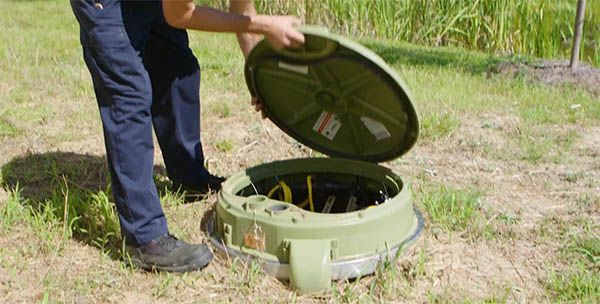SEPTIC-TO-SEWER CONVERSION IN GEORGIA

Bloomingdale, Georgia
Challenge: Failing Septic Tanks
Bloomingdale, Georgia, relied on septic tanks until 1984. When tests were performed, the city discovered that the septic tanks did not perc properly and "the city was just saturated," said Ernie Grizzard, Public Works Superintendent. A moratorium on building permits was issued until a central sewer system was installed.
Solution: Choosing a Central Sewer System
Both pressure sewer and gravity sewer were considered. Pressure sewer was chosen for several reasons, including burial depth for the sewer mains: because frost is not a concern in Bloomingdale, mains are located approximately 3 feet below the surface (pressure sewer mains are buried just below the frost line, which varies by location). Gravity sewer mains commonly require depths of 15 to 20 feet regardless of frost depth.
Result: Long Grinder Pump Life
More than 1000 E/One grinder pumps are installed in Bloomingdale today. Bloomingdale Public Works employs two technicians to maintain the system.
"I wouldn't have believed it, that I could run 1000 pumps with two guys ... I'd have thought it'd take a full crew," Grizzard said. They will go months without receiving a service call.
E/One grinder pumps are designed to be repaired and have enjoyed a long service life with few problems. Bloomingdale has pumps that were installed in 1984 and are still in service; they are replaced with E/One's Extreme Series grinder pump as their service life ends.
- Overview
- Product Catalog
- Product Specifications
- Builders
- Engineers
- Municipalities
- Homeowners
- Knowledge Center
- Design Center
- Sales & Service
- Case Studies
- Rincon Point, California
- Mornington Peninsula, Australia
- Paradise Valley, Arizona
- Locke, California
- Brentwood, Tennessee
- Sacheen Lake, WA
- Flathead Lake, Bigfork, MT
- Big Lake, Skagit County, WA
- Perkins Pond, New Hampshire
- Bloomingdale, Georgia
- Peralta, New Mexico
- Martha's Vineyard, Mass
- Promontory, Park City, Utah
- Reynolds Lake Oconee, Georgia
- Dennis Port, Massachusetts
- Great Sky, Georgia
- Honea Path, South Carolina
- Knoxville, Tennessee
- Hilton Head, South Carolina
- Nashville, Tennessee
- Sweetwater Ranch, Texas
- Jerusalem, New York
- Fairfield Glade, Tennessee
- Florida Keys
- Kohanaiki, Hawaii
- Fallingwater, Pennsylvania
- Seven Lakes, Nova Scotia
- Port Orchard, Washington
- Confluence, PA
- Indianapolis, Marion County, IN
- Patchogue, NY
- Drottningholm, Sweden ›
- Norrtälje, Sweden ›
- Kitö Island, Finland ›
- Article Reprints
- Request More Information
- Distributor Connection
- ISO 9001:2015